Crème Brûlée Cheesecake is a decadent silky cheesecake with a graham cracker crust, a middle layer of torched sugar, a top layer of vanilla pastry cream and of course another layer of bruleed sugar on top of that! It evokes the brilliant flavors of a creme brûlée and marries them with the perfect cheesecake!
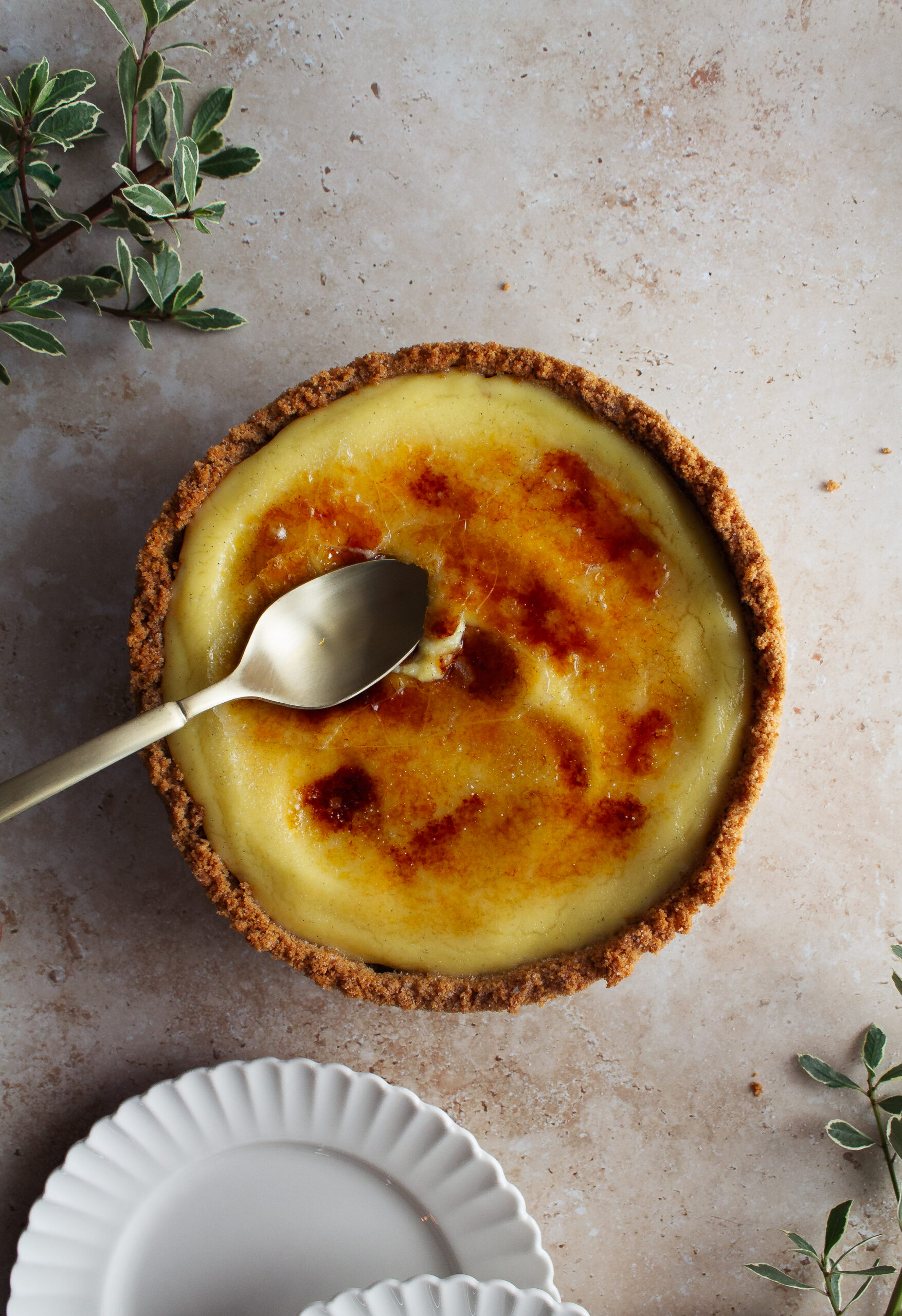
Why this is the best Creme Brûlée Cheesecake
Creme brulee is known for its characteristic crackle top, and its silky notes of vanilla custard. Combining that delicious classic with the perfect cheesecake to make creme brûlée cheesecake is just good sense. My version of this delicious dessert uses a base of my classic cheesecake recipe but with a few additions. It has a middle layer of torched sugar meaning two things:
- You get to play with your blow torch more than once, always a win…
- The torched sugar then gets topped with the rest of the cheesecake batter before it bakes which, when bakes, all melts together for an unexpected caramely center!
Another aspect of this creme brûlée cheesecake that sets it above all others is the silky smooth pastry cream, made with real vanilla bean. The richness of the cheesecake, creaminess of the pastry cream and crunch of the torched sugar top make a feast for the senses!
Follow the tips below to make this delicious creme brulee cheesecake that your family and friends are bound to devour!
How to make graham cracker crust
The graham cracker crust has always been one of my favorite parts of a cheesecake recipe! I love how buttery and crumbly it is and how it compliments the cheesecake so well! My recipe makes sure that you will have ample graham cracker crust in every bite because I figure there must be other people out there who love the crust as much as I do!
The process of making the graham cracker crust is very simple:
- Blitz 2 sleeves of honey graham crackers into fine crumbs. You’ll want to use honey graham crackers, trust me. I’ve tried all the graham crackers out there and this is the one that will give you the best flavor.
- Mix your brown sugar and granulated sugar in with the graham cracker crumbs.
- Melt the butter and stir it into the crumb mixture.
- Line the bottom of a 7″ springform pan with parchment paper and add the graham cracker crust into the pan.
- Press an even layer of the crust onto the bottom and into the sides of the pan. Press hard to make sure the crust is stuck in place before baking it to set.
- Bake for 8-10 minutes and then allow the graham cracker crust to cool before the cheesecake batter gets added.
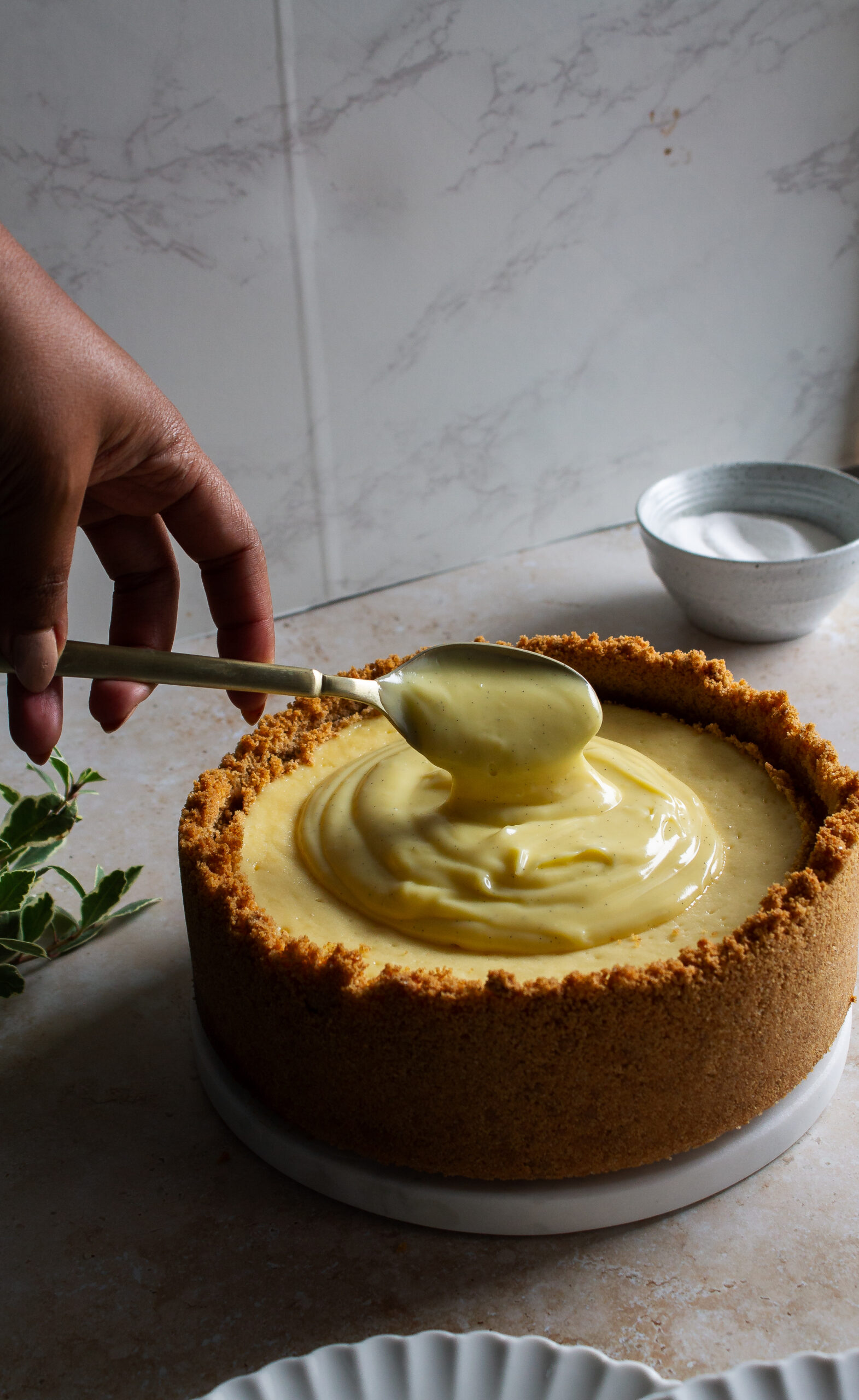
Tips for how to make a Creme Brûlée Cheesecake
I must admit, for some odd reason I always used to think that making cheesecake was a complicated affair. Then I learned and started putting into practice a few simple cheesecake tips that made the process totally approachable! Once you catch on to the cheesecake learning curve, you’ll be baking them like a total pro!
Tip #1–DO NOT OVERMIX the cheesecake batter! In order to create a classic cheesecake that is rich and creamy it is important to mix the ingredients until they are combined and not much longer. If you beat too much air into the batter you’ll risk it cracking when baked and cooled. Plus, you’ll have a light and airy cheesecake which, there is a time and a place for, it’s just not here! Cracked cheesecake still obviously tastes amazing, but if you’re looking for flawless results, pay attention to this step.
Tip #2–Be sure to use ROOM TEMPERATURE ingredients! I can’t emphasize this enough, in every dessert recipe that calls for room temperature ingredients, listen to it! We don’t call for ingredients to be at room temperature to make your life more complicated. There are many reasons ingredients must truly be at room temperature and one of those reasons is because the ingredients will combine much easier when they’re all at room temp!
Tip #3–Use a CHEAT WATER BATH! Listen folks, I don’t have the time, energy or patience to be fooling with a traditional water bath. Unless it is absolutely necessary for the dessert like maybe a crème brûlée…I’m using my cheat water bath method every time! Simply place a rimmed dish on the bottom rack of the oven and fill it with boiling water. Then bake the cheesecake on the top rack of the oven and you’ll get a lot of the same effects as a water bath. Basically you want the steam from the water to soften the bake, so as long as there is steam, you’re in business!
Tip #4–bake the cheesecake LOW AND SLOW! We bake this classic cheesecake at 325F for around 50 minutes.One of the characteristics of a classic cheesecake is the mostly pale top. This is one of the ways we achieve that.
If you LOVE cheesecake, be sure to check out my
- Classic Cheesecake Recipe
- Peach Cobbler Cheesecake Recipe
- Salted Caramel Cheesecake Recipe
- Cookies and Cream Cheesecake Recipe
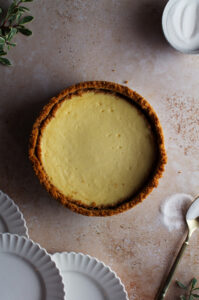
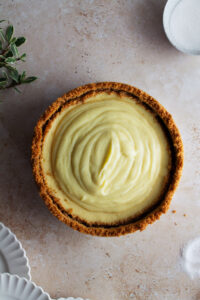
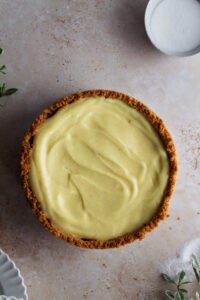
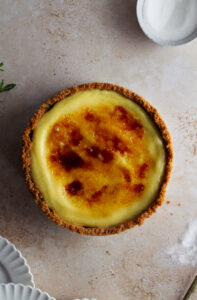
How to bake Creme Brûlée Cheesecake step-by-step
While your graham cracker crust is cooling, it’s time to get to work on the cheesecake batter. Pull out those completely room temperature ingredients and let’s get started!
- Set a kettle or a pot of water to boil and set a deep rimmed pan on the bottom rack of the oven.
- Place the cream cheese in a bowl. I actually prefer to use a hand mixer when making cheesecake because I find it helps me have more control over how much air I’m adding into the batter.
- Beat the cream cheese slightly to break it out of the block form it came in.
- Add the sugars and cornstarch and beat again until combined, but not for too long as previously mentioned. Overbeating can also lead to cracked cheesecake! We add the cornstarch for a little extra insurance against a cracked cheesecake top.
- Add the eggs one at a time and add the vanilla after the last egg is incorporated and beat until combined.
- Switch to a spatula and add the sour cream. Stir until completely mixed in.
- Add the boiled water to the rimmed pan at the bottom of the oven.
- Pour half of the cheesecake batter into the cooled graham cracker crust and sprinkle it with an even layer of sugar.
- Use a handheld blowtorch to brûlée the sugar, then add the remaining cheesecake batter.
- Bake on the rack above the pan of water at 325F for roughly 50 minutes. Remove the cheesecake from the oven when it has a slight wobble.
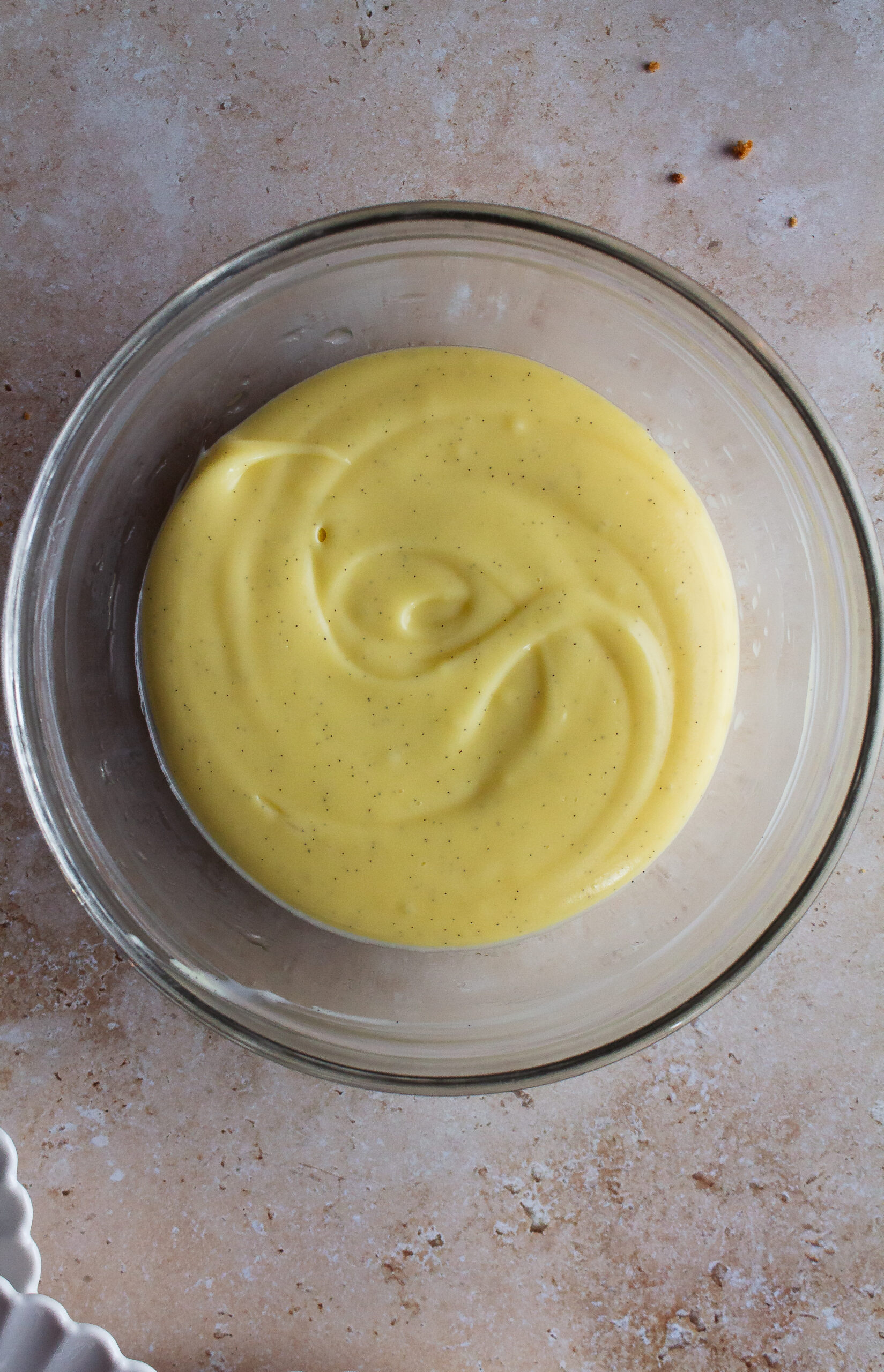
For the Pastry Cream + Brûléed Top
The final layer of this cheesecake is the part that makes it creme brulee, the pastry cream and crackle top! Knowing how to make pastry cream is important as a baker. It’s the first thing I tried to make after watching my first ever season of The Great British Bake Off because it seemed like a pretty important basic. If you follow a few simple science rules, you’ll find success every time!
Tip #1–Warm the vanilla with the milk on a very low heat so that you don’t scorch the milk! You want it to slightly bubble up and then remove it from the heat.
Tip #2–Temper the eggs by pouring a small amount of the warm milk into the whisked egg yolks. This brings the eggs up to temperature so that they don’t curdle (cook) when you return everything to the heat
Tip #3–Pass the finished pastry cream through a sieve to remove any lumps!
Tip #4–When bruleeing the sugar you’ll want to add more than you think you’ll need. The torch responds best when there’s a slightly thicker layer of sugar on top!
You will need a small hand torch to toast the sugar. I used to think they were a kitchen luxury until I finally broke down and bought myself one. To my surprise there are actually lots of affordable handheld torches out there. You can easily spend under $20 on this kitchen tool, and it will pay you back in all of the fun and deliciousness it provides.
Happy Baking!

How to cool cheesecake?
Arguably the most annoying part of making this classic cheesecake is the patience it requires. I always recommend making your cheesecake the night before you want it so that it has time to cool completely in the fridge. Here are the steps I take to allow my classic cheesecake to come up to room temperature slowly, a process that will help you avoid cracks and give you the best creamy texture!
- After the cheesecake has completed baking, turn the oven off and crack open the door of the oven for one hour.
- After the hour of cooling in the oven, remove the cheesecake and set it on the counter for at least 1 hour. The goal here is for the pan to no longer feel warm to the touch so this could take longer than 1 hour.
- Cover the cheesecake and refrigerate it for at least 3 hours or preferably, overnight!
I know the process is tedious but it really helps to not shock the cheesecake with a cooler temperature. We baked it slowly and now we must cool it slowly.
A note on cheesecake pans
One thing about cheesecake is that it can’t be made in a regular cake pan. You will need a springform pan to be able to easily pop out the cheesecake when it’s time to serve it. I a 7” springform pan for my classic cheesecake recipe.
Pro Tip: Place the pan on top of a baking sheet when baking the graham cracker crust and the cheesecake, just in case the butter leaks through, the pan will catch it before it hits the bottom of the oven!

Can baking be therapeutic?
I often talk about baking being a therapeutic hobby but I’d like to share more about why I feel that way as well as how it can become a relaxing hobby for you! When I bake, it’s my creative time. I may put on my favorite nostalgic movie or tv show in the background, or a Spotify playlist titled “French café” and leave my troubles behind.
Sometimes I pour myself a glass of wine and light a candle. Then, with the mood set, the mixing of batter, kneading of dough and smoothing of icing is my only care in the world.
When I say baking is therapeutic, sometimes people respond saying “not for me it isn’t!” I completely understand why someone might feel that way. There have been plenty of times where I spend hours on something only for it to fail or something breaks that shouldn’t or I forget to clean as I go and am left with a disastrous kitchen to clean.
So I should in reality, have a caveat to my “baking as therapy” claims…
Baking is therapy when you curate the experience to be relaxing.
How do you curate that relaxing experience for yourself, you ask?
How to make baking therapeutic…
- Prepare your mind–know that it’s okay if the cake doesn’t rise, or the butter wasn’t chilled enough. Shift your mindset from seeing your failures as mistakes to seeing them as opportunities for learning.
- Prepare your space–I cannot and will not bake on top of a messy kitchen. If I were to do this I would be starting from a place of stress! Take an extra 10 minutes to clean any dishes in the sink and wipe down the counters, this small effort will pay you back greatly in brain space and clarity.
- Clean as you go! I’ll tell you the one way to make baking stressful and tiresome, is to not clean as you go! After I use each ingredient that I no longer need, I put it away.
After each major step in the process, I wipe down the counters and put dishes that are no longer needed in the sink. If there is chill time or baking time I don’t sit, I do the cleaning then. Make this shift and you’ll really notice the difference!
By the way, this last tip really helped me when I was on The Great American Baking Show–and the crew that cleaned up behind us made a point to tell me that my workspace was always so clean they didn’t have much to do!
I would reply by saying “it’s how I stay sane in this tent!”
Additional suggestions:
*Maybe try printing off the recipe instead of looking at it on your phone, tablet or laptop and use this time to unplug from technology for a few hours
**Invite friends or family over to share your creation with you. Time spent with loved ones over food is a universally special experience
And that’s how I discovered baking for my mental health. If you try any of these suggestions, let me know how it went for you! I’m really invested in spreading this message to others in hopes that baking will enhance your lives more than it already does!
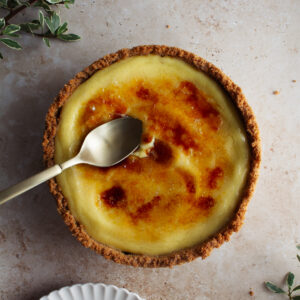
Crème Brûlée Cheesecake
Equipment
- 7" springform pan
- food processor/blender
- parchment paper
Ingredients
For the Graham Cracker Crust
- 2 sleeves (275g) graham cracker pulverized into crumbs
- 2 Tbsp (24g) granulated sugar
- 1 Tbsp (10g) brown sugar
- 1/2 cup (110g)(1 stick) unsalted butter melted
- pinch of salt
For the Cheesecake Batter
- 24 oz (675g) (3 blocks) full fat cream cheese room temperature
- 1 cup (200g) granulated sugar
- 2 Tbsp (20g) brown sugar
- 1 Tbsp cornstarch
- 3 (150-155g) large eggs room temperature
- 2 tsp vanilla bean paste or extract
- 3/4 cup (195g) sour cream room temperature
For the Pastry Cream
- 1 cup (236ml) whole milk
- 1/2 vanilla bean pod scraped, or 1/2 tsp vanilla bean paste
- 1/4 cup (50g) granulated sugar
- 1 1/2 Tbsp (15g) cornstarch
- 1/4 tsp salt
- 2 large (35g) egg yolks
- 1 Tbsp (15g) unsalted butter cold
Instructions
For the Graham Cracker Crust
- Preheat the oven to 350°F (roughly 180°C) and spray a 7" springform pan with parchment paper and cooking spray.
- In a food processor, blitz 2 sleeves (275g) of graham crackers.
- In a medium bowl stir together the graham cracker crumbs, 2 Tbsp (24g) granulated sugar, 1 Tbsp (10g) of brown sugar and a pinch of salt.
- Melt 1/2 cup (110g) of unsalted butter and mix it in with the graham cracker mixture.
- Add the mixture to the lined springform pan and press it down in an even layer on the bottom and up the sides of the pan. I sometimes use a measuring cup to press everything really flat.
- Place the filled springform pan onto a baking sheet (to trap any leakage) and bake for 8-10 minutes. Then remove and allow to cool.
For the Cheesecake Batter
- Set a large pot or a kettle of water to boil, place a rimmed pan in the bottom rack of the oven. Reduce the oven to 325°F (roughly 160°C)
- To a medium bowl, add 24oz (675g) (3 blocks) of full fat cream cheese at room temperature. Use a hand mixer to break down the cream cheese slightly.
- Add 1 cup (200g) of granulated sugar, 2 Tbsp (20g) of brown sugar and 1 Tbsp of cornstarch and cream until combined. Do your best to not add too much air into the cheesecake batter, just mix until well combined.
- Add in 3 large room temperature eggs (150-155g), one at a time, and mix until combined. Then add 2 tsp of vanilla bean paste (or vanilla extract) and mix until incorporated.
- Switch to a spatula and stir in 3/4 cup (195g) of room temperature sour cream until everything is evenly mixed in.
- Pour half of the cheesecake batter into the cooled graham cracker crust and then add an even layer of sugar on top of the batter.
- Using a handheld torch toast the sugar until golden brown. Then add the second half of the cheesecake batter on top and bake for 40-45 minutes or until there is a slight wobble in the middle of the cheesecake.
- Allow the cheesecake to cool completely.
For the Pastry Cream
- While the cheesecake is cooling, add 1 cup (236ml) of whole milk to a saucepan over medium/low heat.
- Scrape the seeds of 1/2 vanilla bean pod and add them to the milk (or add 1/2 tsp of vanilla bean paste). Optionally you can add the vanilla bean pod after being scraped to the milk, just remember to to remove it later on!
- Heat the milk until it is simmering, making sure not to scorch the milk on the bottom of the saucepan.
- In a separate heatproof bowl, whisk together 1/4 cup (50g) of granulated sugar, 1 1/2 Tbsp (15g) of cornstarch, 1/4 tsp of salt and 2 large egg yolks (about 35g). Whisk until smooth and lighter in color, about a minute or so.
- Scoop about 1/4 cup of the warm milk mixture and slowly pour it into the egg mixture whisking continuously until everything is mixed together.
- Pour the egg mixture that has been brought up to temperature by the warm milk back into the saucepan with the rest of the milk.
- Stir continuously over low heat until the mixture thickens. Then remove it from the heat.
- Stir in 1 Tbsp (15g) of cold unsalted butter until it melts into the pastry cream.
- Pass the pastry cream through a sieve to remove any lumps and then cover it with plastic wrap so that the plastic wrap is touching the pastry cream. Refrigerate for 1 hour.
For the Assembly
- Remove the completely chilled cheesecake and pastry cream from the fridge.
- Add the pastry cream on top of the cheesecake and spread it in an even layer.
- Add an even layer of sugar overtop of the cheesecake and use your handheld torch to toast it until it is golden brown.
- Serve and enjoy! Best when eaten 1 or 2 days after making!

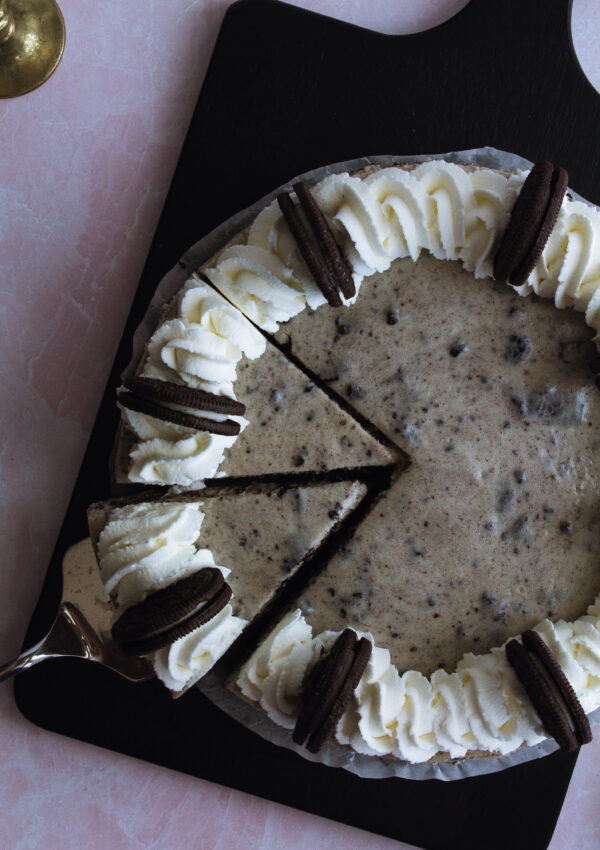
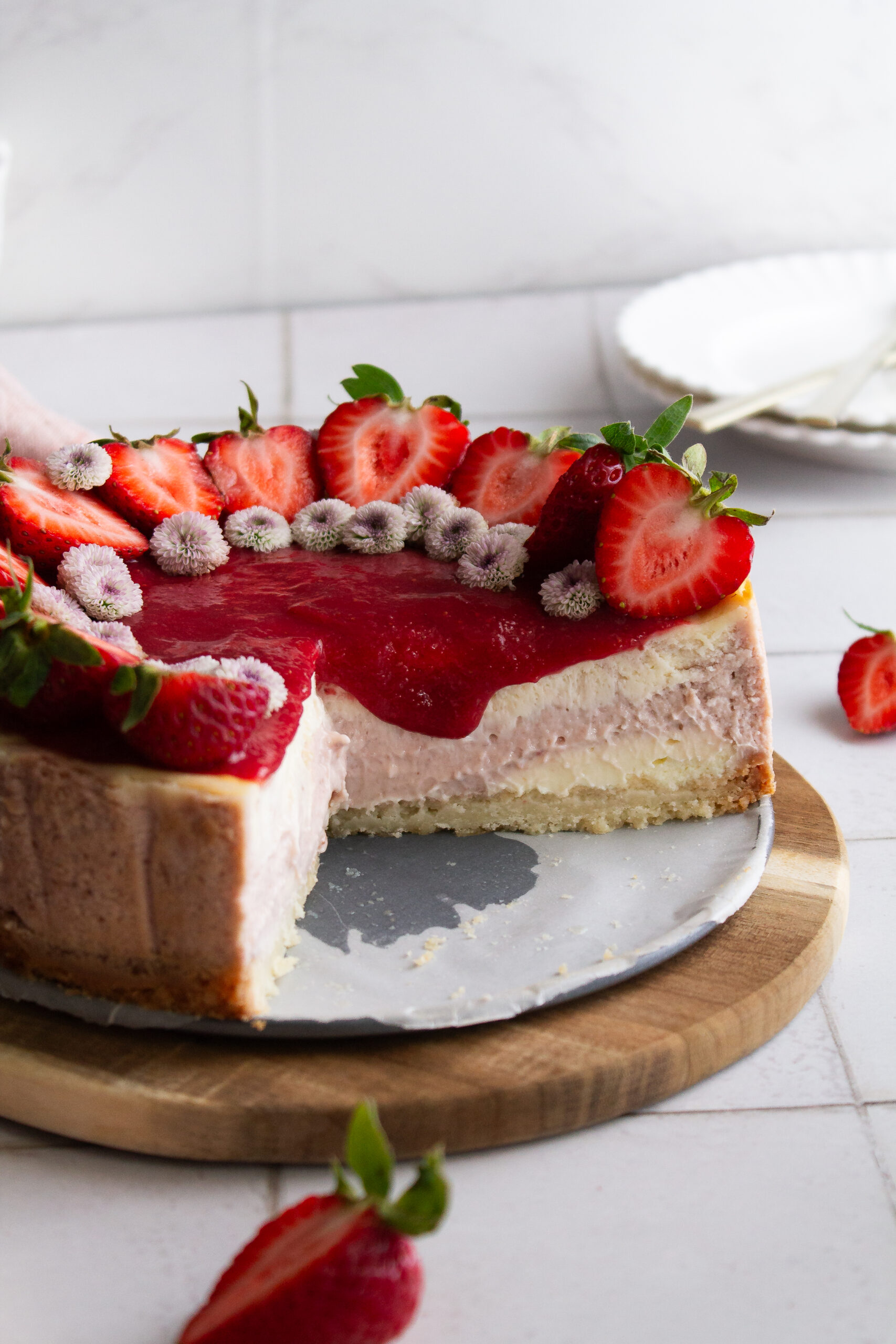
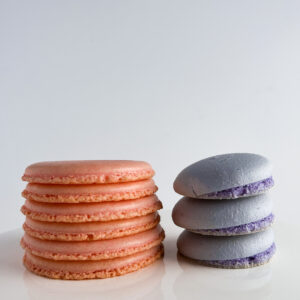
[…] Crème Brûlée Cheesecake […]